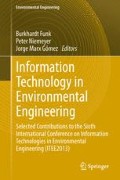Abstract
A need exists for behaviour change and transparency in modern organisations where the focus needs to shift towards sustainability thinking rather than just sustainability reporting for compliance reasons. The number of organisations which are undertaking Green Initiatives and reporting on sustainability are increasing. However, many of these organisations are not viewing these initiatives strategically. The effect on information requirements and business processes is often not considered and the available tools and technologies are not used to their full potential. As a result, whilst sustainability reports are produced, the underlying infrastructure consists of “sustainability silos” comprising of a lack of integrated systems, inconsistent data and information where the integrity is not reliable. In order to address these issues this study investigates the extent to which organisations consider environmental information requirements and processes when planning their information systems and Enterprise Architecture (EA). The inclusion of Green Initiative strategies into the design of an organisation’s enterprise systems and EA is proposed. This will ensure alignment between environmental management and IT planning and result in integrated systems, an improved sustainability reporting process and more effective decision making regarding the environmental impact of organisations.
Access this chapter
Tax calculation will be finalised at checkout
Purchases are for personal use only
References
Elkington J (1994) Towards the sustainable corporation: Win–Win–Win Business strategies for sustainable development. Calif Manage Rev 36(2):90–100
GRI (2011) Sustainability reporting guidelines © 2000–2011
Solsbach A, Isenmann R, Marx Gómez J (2010) Network publicity—an approach to sustainability reporting from a network view. In: International society for ecological economics 11th biennial conference: advancing sustainability in a time of crisis
Ernst and Young (2012) Six growing trends in corporate sustainability. Available at: http://www.ey.com/US/en/Services/Specialty-Services/Climate-Change-and-Sustainability-Services/Six-growing-trends-in-corporate-sustainability_overview. Accessed 10 June 2012
Magoulas T, Hadzic A, Saarikko T, Pessi K (2012) Alignment in enterprise architecture: A comparative analysis of four architectural approaches. Elect J Info Sys Eval 15(1):88–101
Carlson R, Erixon M, Forsberg P, Pålsson A (2001) System for integrated business environmental information management. Adv Environ Res 5:369–375
Scholtz B, Calitz A, Eastes B (2012) A balanced scorecard for sustainability reporting a balanced scorecard for sustainability reporting. The 6th business international conference: economic, social and technological environment, pp 1–24
Klein J, Gagliardi M (2010) A workshop on analysis and evaluation of enterprise architectures. Software Engineering Institute, p 429
ISO, 2011. ISO/IEC/IEEE. ISO/IEC/IEEE FDIS 42010: 2011 standard.
KPMG International Cooperative (KPMG) (2011) Integrated reporting. Performance insight through better business reporting—issue 1. Available from: http://www.kpmg.com/Global/en/IssuesAndInsights/ArticlesPublications/Documents/road-to-integrated-reporting.pdf. Accessed 1 Oct 2011
Deloitte and Touche (2002) Deloitte sustainability reporting scorecard
Speshock CH (2010) Empowering green initiatives with IT: a strategy and implementation guide. Wiley, New Jersey
Rea MH (2012) KING III and GRI + 13, 2012 review of sustainability reporting in South Africa as per the global reporting initiative (GRI) guidelines. Integrated reporting and assurance services (IRAS)
Scholtz B, Connolley A, Solsbach A (2012) A gap analysis for environmental reporting at a South African manufacturing company. The 6th business international conference: economic, social and technological environment, pp 1–24
Velitchkov I (2008) Integration of IT strategy and enterprise architecture models. Paper presented at the international conference on computer systems and technologies, New York
Wang X, Zhou X, Jiang L (2008) A method of business and IT alignment based on enterprise architecture. Service operations and logistics. IEEE international conference, pp 740–745
Ross JW, Weill P, Robertson DC (2006) Enterprise architecture as strategy. Harvard Business School Press, Boston
Baltzan P, Phillips A, Haag S (2009) Business driven technology with premium content, 4th edn. McGraw-Hill Higher Education, New York
Butler JB, Henderson SC, Raiborn C (2011) Sustainability and the balanced scorecard: integrating green measures into business reporting. Manag Account Q 12 (2):1–10. (Winter 2011)
Solsbach A, Süpke D, Wagner B, Marx Gómez J (2011) Sustainable online reporting model—a web based sustainability reporting software. Environ Sci Eng 3(Part 2):165–177
Athanasiadis IN (2006) By interweaving and interpreting data streams, AISLE can bring crucial environmental information to a wider audience. Lect Notes Comput Sci 34–39
Author information
Authors and Affiliations
Corresponding author
Editor information
Editors and Affiliations
Rights and permissions
Copyright information
© 2014 Springer-Verlag Berlin Heidelberg
About this chapter
Cite this chapter
Scholtz, B., Connolley, A., Calitz, A. (2014). Enterprise Architectures for Addressing Sustainability Silos. In: Funk, B., Niemeyer, P., Gómez, J. (eds) Information Technology in Environmental Engineering. Environmental Science and Engineering(). Springer, Berlin, Heidelberg. https://doi.org/10.1007/978-3-642-36011-4_12
Download citation
DOI: https://doi.org/10.1007/978-3-642-36011-4_12
Published:
Publisher Name: Springer, Berlin, Heidelberg
Print ISBN: 978-3-642-36010-7
Online ISBN: 978-3-642-36011-4
eBook Packages: Earth and Environmental ScienceEarth and Environmental Science (R0)

